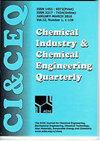Bioaccumulation and biosorption study of heavy metals removal by Cyanobacteria Nostoc sp.
IF 0.8
4区 工程技术
Q4 CHEMISTRY, APPLIED
Chemical Industry & Chemical Engineering Quarterly
Pub Date : 2023-01-01
DOI:10.2298/ciceq220511002r
引用次数: 0
Abstract
Nowadays various industrial and urban activities are resulting in discharging of enormous quantities of various pollutants and their accumulation in the environment. Considering that the presence of heavy metals in wastewater is a serious threat to the environment and human health and that conventional methods for their removal are not highly efficient, the current study mainly focuses to estimate cyanobacterial capability to accumulate different heavy metals from water and compare bioaccumulation and biosorption processes. Cyanobacteria Nostoc sp. was used and five heavy metals were selected for this experiment (Cd2+, Cu2+, Pb2+, Ni2+, Zn2+). Examined concentrations of HMs were 20, 80 and 200 mg/dm3 for the bioaccumulation study while for biosorption experiments 20 and 80 mg/dm3 of each HMs were used. Living cells of Nostoc sp. have the highest affinity for Pb2+ (98.15%) and Cu2+ (95.14%) removal from the solution by bioaccumulation. During the biosorption process, dried biomass of Nostoc sp., besides Pb2+ (92.27%) and Cu2+ (96.00%), shows a high affinity for Cd2+ (91.00%) removal. Living cyanobacterial cells of Nostoc sp. was capable to accumulate 82% of Zn, while dried biomass adsorbs 87% of Zn2+. The highest bioaccumulation of Ni2+ was only 38% while using the process of biosorption it was significantly higher (63.80%). These results could provide a preliminary study for further investigation in the direction of the development of immobilized biosorbents which could be used for industrial effluent treatment.蓝藻去除重金属的生物积累与生物吸附研究。
如今,各种工业和城市活动导致大量各种污染物的排放和它们在环境中的积累。考虑到废水中重金属的存在对环境和人类健康的严重威胁,以及传统的去除方法效率不高,目前的研究主要集中在评估蓝藻对水中不同重金属的富集能力,并比较生物富集和生物吸附过程。以蓝藻Nostoc sp.为研究对象,选取5种重金属(Cd2+、Cu2+、Pb2+、Ni2+、Zn2+)作为实验材料。生物积累实验中,HMs的检测浓度分别为20、80和200 mg/dm3,生物吸附实验中,每种HMs的检测浓度分别为20和80 mg/dm3。Nostoc sp.活细胞对Pb2+(98.15%)和Cu2+(95.14%)的生物富集去除效果最好。在生物吸附过程中,除Pb2+(92.27%)和Cu2+(96.00%)外,Nostoc sp.的干燥生物质对Cd2+(91.00%)具有较高的去除亲和力。Nostoc sp.活的蓝藻细胞能够积累82%的Zn,而干燥的生物质吸附87%的Zn2+。Ni2+的最高生物积累量仅为38%,而采用生物吸附法的Ni2+的最高生物积累量为63.80%。这些结果为进一步研究固定化生物吸附剂的发展方向提供了初步的研究,并可用于工业废水的处理。
本文章由计算机程序翻译,如有差异,请以英文原文为准。
求助全文
约1分钟内获得全文
求助全文
来源期刊

Chemical Industry & Chemical Engineering Quarterly
CHEMISTRY, APPLIED-ENGINEERING, CHEMICAL
CiteScore
2.10
自引率
0.00%
发文量
24
审稿时长
3.3 months
期刊介绍:
The Journal invites contributions to the following two main areas:
• Applied Chemistry dealing with the application of basic chemical sciences to industry
• Chemical Engineering dealing with the chemical and biochemical conversion of raw materials into different products as well as the design and operation of plants and equipment.
The Journal welcomes contributions focused on:
Chemical and Biochemical Engineering [...]
Process Systems Engineering[...]
Environmental Chemical and Process Engineering[...]
Materials Synthesis and Processing[...]
Food and Bioproducts Processing[...]
Process Technology[...]
 求助内容:
求助内容: 应助结果提醒方式:
应助结果提醒方式:


